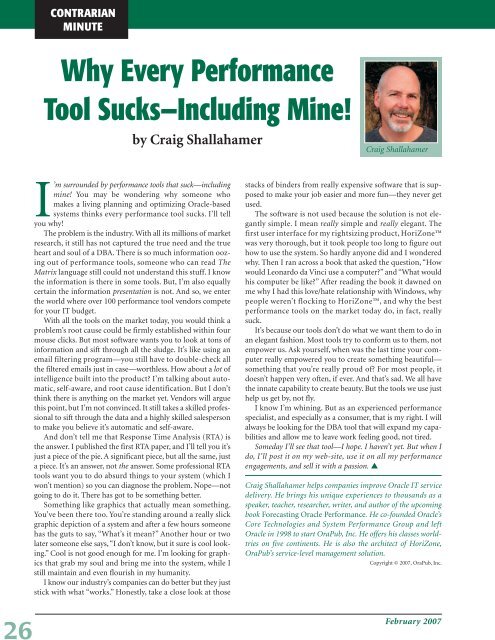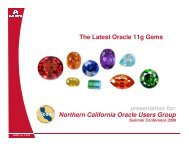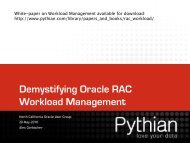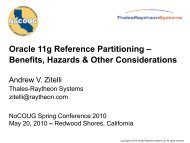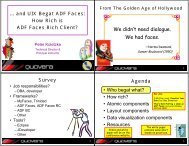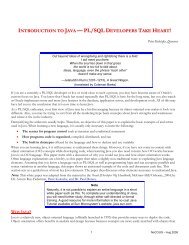Q&A with Juan Loaiza Stay Focused on the Five Steps ... - NoCOUG
Q&A with Juan Loaiza Stay Focused on the Five Steps ... - NoCOUG
Q&A with Juan Loaiza Stay Focused on the Five Steps ... - NoCOUG
You also want an ePaper? Increase the reach of your titles
YUMPU automatically turns print PDFs into web optimized ePapers that Google loves.
CONTRARIAN<br />
MINUTE<br />
Why Every Performance<br />
Tool Sucks—Including Mine!<br />
by Craig Shallahamer<br />
I’m surrounded by performance tools that suck—including<br />
mine! You may be w<strong>on</strong>dering why some<strong>on</strong>e who<br />
makes a living planning and optimizing Oraclebased<br />
systems thinks every performance tool sucks. I’ll tell<br />
you why!<br />
The problem is <strong>the</strong> industry. With all its milli<strong>on</strong>s of market<br />
research, it still has not captured <strong>the</strong> true need and <strong>the</strong> true<br />
heart and soul of a DBA. There is so much informati<strong>on</strong> oozing<br />
out of performance tools, some<strong>on</strong>e who can read The<br />
Matrix language still could not understand this stuff. I know<br />
<strong>the</strong> informati<strong>on</strong> is <strong>the</strong>re in some tools. But, I’m also equally<br />
certain <strong>the</strong> informati<strong>on</strong> presentati<strong>on</strong> is not. And so, we enter<br />
<strong>the</strong> world where over 100 performance tool vendors compete<br />
for your IT budget.<br />
With all <strong>the</strong> tools <strong>on</strong> <strong>the</strong> market today, you would think a<br />
problem’s root cause could be firmly established <str<strong>on</strong>g>with</str<strong>on</strong>g>in four<br />
mouse clicks. But most software wants you to look at t<strong>on</strong>s of<br />
informati<strong>on</strong> and sift through all <strong>the</strong> sludge. It’s like using an<br />
email filtering program—you still have to doublecheck all<br />
<strong>the</strong> filtered emails just in case—worthless. How about a lot of<br />
intelligence built into <strong>the</strong> product? I’m talking about automatic,<br />
selfaware, and root cause identificati<strong>on</strong>. But I d<strong>on</strong>’t<br />
think <strong>the</strong>re is anything <strong>on</strong> <strong>the</strong> market yet. Vendors will argue<br />
this point, but I’m not c<strong>on</strong>vinced. It still takes a skilled professi<strong>on</strong>al<br />
to sift through <strong>the</strong> data and a highly skilled salespers<strong>on</strong><br />
to make you believe it’s automatic and selfaware.<br />
And d<strong>on</strong>’t tell me that Resp<strong>on</strong>se Time Analysis (RTA) is<br />
<strong>the</strong> answer. I published <strong>the</strong> first RTA paper, and I’ll tell you it’s<br />
just a piece of <strong>the</strong> pie. A significant piece, but all <strong>the</strong> same, just<br />
a piece. It’s an answer, not <strong>the</strong> answer. Some professi<strong>on</strong>al RTA<br />
tools want you to do absurd things to your system (which I<br />
w<strong>on</strong>’t menti<strong>on</strong>) so you can diagnose <strong>the</strong> problem. Nope—not<br />
going to do it. There has got to be something better.<br />
Something like graphics that actually mean something.<br />
You’ve been <strong>the</strong>re too. You’re standing around a really slick<br />
graphic depicti<strong>on</strong> of a system and after a few hours some<strong>on</strong>e<br />
has <strong>the</strong> guts to say, “What’s it mean?” Ano<strong>the</strong>r hour or two<br />
later some<strong>on</strong>e else says, “I d<strong>on</strong>’t know, but it sure is cool looking.”<br />
Cool is not good enough for me. I’m looking for graphics<br />
that grab my soul and bring me into <strong>the</strong> system, while I<br />
still maintain and even flourish in my humanity.<br />
I know our industry’s companies can do better but <strong>the</strong>y just<br />
stick <str<strong>on</strong>g>with</str<strong>on</strong>g> what “works.” H<strong>on</strong>estly, take a close look at those<br />
Craig Shallahamer<br />
stacks of binders from really expensive software that is supposed<br />
to make your job easier and more fun—<strong>the</strong>y never get<br />
used.<br />
The software is not used because <strong>the</strong> soluti<strong>on</strong> is not elegantly<br />
simple. I mean really simple and really elegant. The<br />
first user interface for my rightsizing product, HoriZ<strong>on</strong>e<br />
was very thorough, but it took people too l<strong>on</strong>g to figure out<br />
how to use <strong>the</strong> system. So hardly any<strong>on</strong>e did and I w<strong>on</strong>dered<br />
why. Then I ran across a book that asked <strong>the</strong> questi<strong>on</strong>, “How<br />
would Le<strong>on</strong>ardo da Vinci use a computer?” and “What would<br />
his computer be like?” After reading <strong>the</strong> book it dawned <strong>on</strong><br />
me why I had this love/hate relati<strong>on</strong>ship <str<strong>on</strong>g>with</str<strong>on</strong>g> Windows, why<br />
people weren’t flocking to HoriZ<strong>on</strong>e, and why <strong>the</strong> best<br />
performance tools <strong>on</strong> <strong>the</strong> market today do, in fact, really<br />
suck.<br />
It’s because our tools d<strong>on</strong>’t do what we want <strong>the</strong>m to do in<br />
an elegant fashi<strong>on</strong>. Most tools try to c<strong>on</strong>form us to <strong>the</strong>m, not<br />
empower us. Ask yourself, when was <strong>the</strong> last time your computer<br />
really empowered you to create something beautiful—<br />
something that you’re really proud of? For most people, it<br />
doesn’t happen very often, if ever. And that’s sad. We all have<br />
<strong>the</strong> innate capability to create beauty. But <strong>the</strong> tools we use just<br />
help us get by, not fly.<br />
I know I’m whining. But as an experienced performance<br />
specialist, and especially as a c<strong>on</strong>sumer, that is my right. I will<br />
always be looking for <strong>the</strong> DBA tool that will expand my capabilities<br />
and allow me to leave work feeling good, not tired.<br />
Someday I’ll see that tool—I hope. I haven’t yet. But when I<br />
do, I’ll post it <strong>on</strong> my web-site, use it <strong>on</strong> all my performance<br />
engagements, and sell it <str<strong>on</strong>g>with</str<strong>on</strong>g> a passi<strong>on</strong>. <br />
Craig Shallahamer helps companies improve Oracle IT service<br />
delivery. He brings his unique experiences to thousands as a<br />
speaker, teacher, researcher, writer, and author of <strong>the</strong> upcoming<br />
book Forecasting Oracle Performance. He co-founded Oracle’s<br />
Core Technologies and System Performance Group and left<br />
Oracle in 1998 to start OraPub, Inc. He offers his classes worldtries<br />
<strong>on</strong> five c<strong>on</strong>tinents. He is also <strong>the</strong> architect of HoriZ<strong>on</strong>e,<br />
OraPub’s service-level management soluti<strong>on</strong>.<br />
Copyright © 2007, OraPub, Inc.<br />
February 2007


